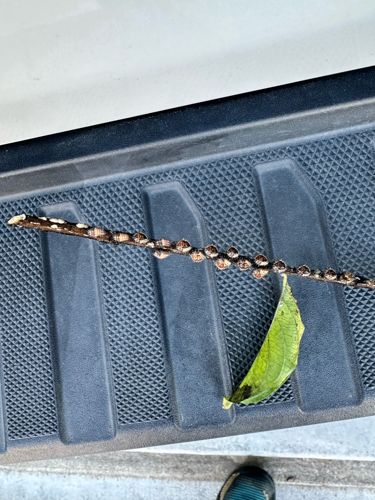Butterfly (Chrysalis stage) and Soft Scales
Scientific Name: Chrysalis: Difficult to determine without the adult butterfly; likely a species within the Nymphalidae family. Scales: Likely a species within the Coccidae family, such as _Coccus hesperidum_ (Brown Soft Scale) or similar, but precise identification without microscopic examination is not possible from the image.
Order & Family: Chrysalis: Order Lepidoptera (Butterflies and Moths), Family Nymphalidae (Brush-footed Butterflies) or similar. Scales: Order Hemiptera, Superfamily Coccoidea (Scale Insects), Family Coccidae (Soft Scales) or similar.
Size: The chrysalis appears to be a few centimeters in length, typical for many butterfly species. The individual scale insects appear to be a few millimeters in diameter. The stick itself provides context for their size.

Natural Habitat
Butterflies and their chrysalises are found in a wide variety of habitats where their host plants grow, including gardens, fields, forests, and meadows. Scale insects are found on the stems, leaves, and branches of many types of plants and trees, both indoors and outdoors.
Diet & Feeding
The chrysalis itself does not feed; it is a transformative stage. The scale insects on the stick feed on plant sap. Adult butterflies (which would emerge from the chrysalis) typically feed on nectar from flowers.
Behavior Patterns
The image clearly shows the chrysalis (pupa) stage of a butterfly, which means it undergoes complete metamorphosis. The chrysalis is formed after the larval (caterpillar) stage and before the adult butterfly emerges. The small, bead-like structures on the stick appear to be individual scale insects, specifically soft scales, which are typically sessile (immobile) once they reach maturity. They feed by sucking sap from the plant. Butterflies, as adults, are typically active during the day (diurnal) and fly to find nectar sources and mates. Scale insects, particularly in their immobile adult stages, are largely sessile and their 'behavior' is limited to feeding and reproduction from a fixed position.
Risks & Benefits
Adult butterflies are important pollinators, contributing to the reproduction of many plants, including agricultural crops. Their larvae (caterpillars) can sometimes cause defoliation, but this is usually not a significant issue unless populations are very high. Scale insects are considered pests in horticulture and agriculture. They can weaken plants by feeding on sap, leading to stunted growth, yellowing leaves, and in severe infestations, plant death. They also excrete 'honeydew,' a sugary substance that can promote the growth of sooty mold, further hindering photosynthesis and reducing plant aesthetic value. They do not pose direct risks to humans.
Identified on: 8/9/2025